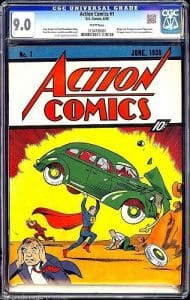by Gary R. Sullivan
As influential as our formative years are on our psychological, emotional, and physical development, so too are they influential on what we choose to surround ourselves with later in life. Collectibles dealers refer to it as the “Twenty Year Rule,” in which people are nostalgically drawn towards something which excited within them a sense of wonderment, which as adults they long to recapture.
For baby boomers like myself, those items of fascination may be a long-lost 1950’s Lionel train set they once possessed, a Golden Age Action Comics title they read until the pages fell out, or their parent’s departed 1958 Plymouth Fury. These are all vintage items, likely out of their price range today. For Generation X through Millennials, however, the childhood items they now covet are more than likely the product of creative intellectual properties, first experienced in a darkened theatre or while watching Saturday morning cartoons. They established a tactile connection with the mass-manufactured, licensed iterations of these programs.
They were able to hold that movie magic in their hand.
And those objects evolved from what many considered mere children’s toys into respected ‘collectibles,’ and the children who originally held them, into adults. They’ve grown in synergy – the latter in size and the former not only in value, but in scope. This evolution has driven an explosion in the growth of high-end toy manufacturing, from 1/6 scales to screen accurate movie prop recreations and beyond. It has made the world of collecting financially accessible to generations who may not have been able to otherwise.
Over the last 20 years, the world of antique collecting has changed significantly, the most dramatic changes taking place in just the last 5 years. This has been primarily due to the explosion of the internet as a source and an outlet for antiques and collectibles. Gone are the days of prowling through antique shops in the hopes of finding that Holy Grail item to complete your collection – we live in an age of instant, on-demand gratification. Millennials and Gen Xers are eschewing the pursuit of high-value antiques in favor of more easily accessible pop culture collectibles that speak to both their nostalgia and their bank accounts. This is not to say that these generations are wholly disinterested in the antique market; on the contrary, there is a definite appeal to the decorative aspect of anything “antique” or “vintage.” They simply do not possess the desire coupled with the necessary discretionary income to invest in expensive heirlooms.
The under-40’s are blazing new trails when it comes to collecting behavior and the spaces in which they live. A side effect of being the most highly educated generations in history, they often find themselves saddled with student loan debt until well into adulthood and buying a home is outside the realm of possibility for many. They follow the jobs that their expensive educations have qualified them for, often into large cities where rents are high and space is limited. They travel light, so the accumulation of “stuff,” and especially expensive and fragile stuff, is less than ideal. They spend their discretionary income (if they have any) on experiences and events, and on improving their access to the many forms of technology that keep them connected to the outside world. There’s an increased interest in tiny houses and living sustainably. Less emphasis is being placed on preserving the objects from our past than by previous generations.
Younger generations have also grown up in a world where pop culture is ever present in their lives and has become woven into the fabric of their adult selves. With the onset of virtual reality, interactive games and apps, and the popularity of social media, they no longer look at celebrities, pop culture figures, or fictional characters as fantasy idols, but interface with them directly and integrate them into their daily lives. The things Millennials and Generation X adults love become a part of them in ways previously impossible.
So, how does this relate to the future of collectibles and collecting?
Revising “Collectible” for New Generations of Collectors
First and foremost, we should address the somewhat recent expansion of what would commonly be considered a collectible, especially to younger adults. While older collectors might think of more traditional items such as model trains, antique clocks, dolls, or coins, there has been a distinct rise in the popularity of more mass-produced and easily acquired items like action figures and molded vinyl figures called Funko Pops. Big box stores like Target and Wal-Mart have even added specific “Collectibles” sections to their retail locations. They offer these pop culture pieces and make an effort to further distinguish them from the realm of children’s toys. Collecting is becoming cool in a way it never was before, due primarily to the ability to customize collections to suit the consumer’s needs, budget, and space restrictions.
The popularity of Funko vinyl figures is a great illustration of how the world of collectibles is charging into the pop culture future. Diversity: to date, over 6,000 different characters have been created so there’s a great chance you’d find a favorite character from a movie, series or game. Availability: you’d be hard pressed to find a store that doesn’t sell them, not to mention the internet and the secondary market on eBay, etc. Affordability: the average price for a figure is around $10, which makes them easy to collect for people at all socioeconomic levels.
Exclusivity: hardcore collectors can spend years tracking down exclusive/ Chase/limited edition figures, some of which are extremely rare and can sell for thousands of dollars. Collectibility: at only 4″ high, these figures look great on a shelf, bookcase, desk, nightstand – anywhere you could use a little bobble-headed cheer (in or out of the box).
Figures of Today = Figurines of the Past
Today, companies like NECA, Sideshow, and S.H. Figuarts are dominating the collectibles market with their “don’t call it a toy” lines of beautifully sculpted, fully articulated, and meticulously painted figures and statues. These items are a little pricier (and sometimes a lot pricier) than a Funko, but they’re beautiful showpieces for any adult collector to display in their home. From 1/8 scale figures to life-sized replicas, these companies give collectors room to grow their collections in tandem with their incomes, and many sell on the secondary market for much more than their initial retail price.
Collectibles that “Prop” Up the Market
Another interesting realm of collecting that was born (or at the very least, made more commonplace) by the rise of pop culture collectibles is that of screen-used film and television props. Many pop culture collectors who began accumulating pieces related to their favorite movies and television shows as children find themselves drawn to the screen-used prop market as their income bracket goes up. Auction houses such as the Prop Store and Profiles in History can help even the most discerning (and deep pocketed) film buff find the pièce de résistance to complete their collection, and satisfy the collector’s urge to own something unique, rare, and culturally important.
The Downside of Mass-Manufactured Pop Pieces
While many pop culture collectibles can increase significantly in value as time goes by, they may be a bit more of a risky financial investment than traditional antiques. In some cases a small initial purchase can reap fantastic rewards (like the copy of Action Comics #1, purchased in 1938 for $0.10 that sold for $3.2M in 2014), but for most pop culture collectors the only significant value of their collections is sentimental. Exclusivity means less today than it ever has previously because manufacturing and distributing collectibles is so easy.
Collectors have always enjoyed showing off their collections to anyone who is interested. We are proud of what we’ve collected and want to share it. The biggest change to the collectibles market in the past 10 years is not in the collectibles themselves, but rather how we share them with the world. In this day and age, it is important for collectors to have a digital showcase to not only catalogue and display their collectibles, but also to connect with others who love the same things.
All collectors are driven to share scholarship and attain additional knowledge in their collecting category. This is true whether their passion is for mainstream collectibles, or the more obscure. Through the internet, today’s collectors can enjoy a real sense of community centered around their collecting interests. Gemr.com has stepped up to offer a home for collectors of all kinds, no matter what they collect. They can show off their collections, create a digital inventory of all of their collectibles, chat, buy, and sell with other enthusiasts who share their passions.
Are you a movie buff who traded in your DVDs for streaming services? Create a digital collection of every film you’ve seen (or want to see). Perhaps you’re an antique aficionado who needs help identifying your latest find? Connect with other enthusiasts and get some advice! Maybe you simply don’t have space in your home to display your entire collection – but you’ll never run out of virtual shelf space on Gemr. The app is a great way to take your collection with you everywhere you go and connect with a growing membership of fellow collectors and fans. The face of collectibles is changing, and the way in which we collect is moving into the future as well.
About the Author:
Antique clock dealer and early American furniture expert Gary R. Sullivan has passionately pursued the world of antiques and collectibles since the age of 10 and is now a nationally recognized authority on early American clocks. His passion for collecting as a youngster quickly developed into a rewarding vocation that continues to hold his interest more than 40 years later.
Through the years, Gary has kept a sharp focus on the market and has made adjustments in his business model in order to stay in step with the ebb and flow of the constantly changing market.
In the 1970s he began at the ground floor of the business, exhibiting at flea markets and small antiques shows. For many years, he conducted his business as a “picker,” liquidating estates and supplying other dealers with material.
Gary is an award-winning author and has written and contributed to several books and articles on clocks and furniture and he frequently lectures on those subjects. Gary shares his expertise as a clock and furniture expert through ongoing appearances on Antiques Roadshow. He has also appeared in several episodes of Find! and The New Yankee Workshop.
As Co-Founder of Gemr.com (pronounced, “Jemmer”), a social website and mobile app for collectors, Gary has now turned his attention to the online collecting world. His goal is to create a place for collectors show off their treasures and interact with like-minded collectors, no matter what their passion. The site consists of countless collector clubs inhabited by hundreds of thousands of enthusiasts. In addition to antiques aficionados, tech-savvy younger collectors, primarily of pop-culture related material, have been flocking to the site.














Related posts: